Research: The State of Upskilling and Reskilling in 2024
New research by TalentLMS and Workable unveils how spot-on upskilling and reskilling initiatives in U.S. companies are. The report features 10 tactics to amp up your skilling initiatives. Plus, 5 L&D experts share their views.

Key takeaways
Hitting the spot
71% of employees are satisfied with the upskilling and reskilling training.
Learning with purpose
77% agree that learning new skills gives them a sense of purpose.
AI adoption
39% use AI skills in their role, while half say AI would benefit their job.
Introduction
In an increasingly dynamic work landscape, upskilling and reskilling have emerged from the L&D wings. They’ve moved center stage to support agility, and joined hands to provide resilience. But are companies currently providing enough upskilling and reskilling options? To find out, TalentLMS partnered with Workable on new research.
We surveyed 1,000 employees working for U.S. companies, each of whom received upskilling and/or reskilling training in the past year. The aim of our research? To learn more about the upskilling and reskilling programs they’ve participated in the last year. And to uncover how employees feel about them.
What did we find? Yes, there are potential obstacles. But what emerged was a clear, collective aspiration toward continuous learning. Seventy-one percent of employees would like to update their skills more often. Moreover, an overwhelming majority (80%) want companies to invest more in upskilling and reskilling.
That’s not all.
We already knew that 66% of employees link skills growth with success. What inspired us to dig deeper into their motivation and mindset. And explore how well employers are meeting workers’ needs.
So we drilled down into the ‘why’. And uncovered that the top 3 influencing factors for upskilling and reskilling are rooted not just in success, but survival too.
Among the key “success” motivators were opportunities for personal growth. Along with the ability to adapt and thrive when faced with new technologies.
The data didn’t just pick up on the implications of a widening skills gap either. It also exposed an age gap in relation to upskilling and reskilling.
Are generational differences enough to give L&D professionals cause for reevaluating strategies and solutions? What other factors do HR teams need to consider? Let’s dig deeper into the data to find out.
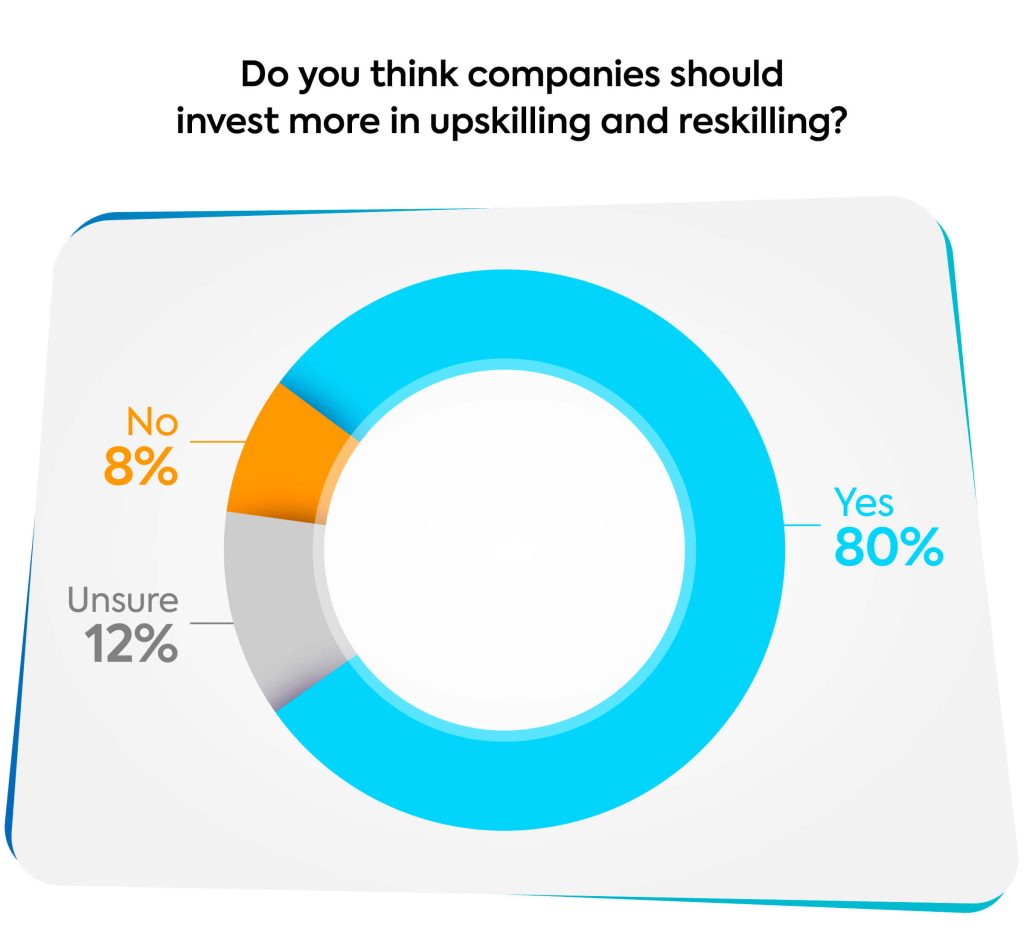
- Upskilling & reskilling in review
- What motivates employees to learn new skills
- Unlocking employee potential
- 10 tactics to improve skill development initiatives
- A generational divide in satisfaction
- Obstacles to upskilling and reskilling
- What skill-building programs look like
- 5 key trends to track
- Conclusion
How spot-on are upskilling and reskilling programs?
In corporate training, higher levels of learner satisfaction equal better learning outcomes. And, in turn, better business outcomes. According to data from Deloitte, engagement and retention rates for employees are 30 to 50% higher in organizations with a strong learning culture.
71% of employees are satisfied with the upskilling and reskilling training provided by their employer.
Not only that, but businesses with a healthy training ecosystem are 52% more productive, and 92% more likely to develop novel products and processes. Plus, they’re 56% more likely to be the first to market with their products and services, and 17% more profitable than their peers. In short, when employees are happy with training, everyone wins.
So, how do our respondents feel about the upskilling and reskilling programs they’ve received? Our data reveals a positive picture overall, underpinned by some clear calls to action for HR teams.
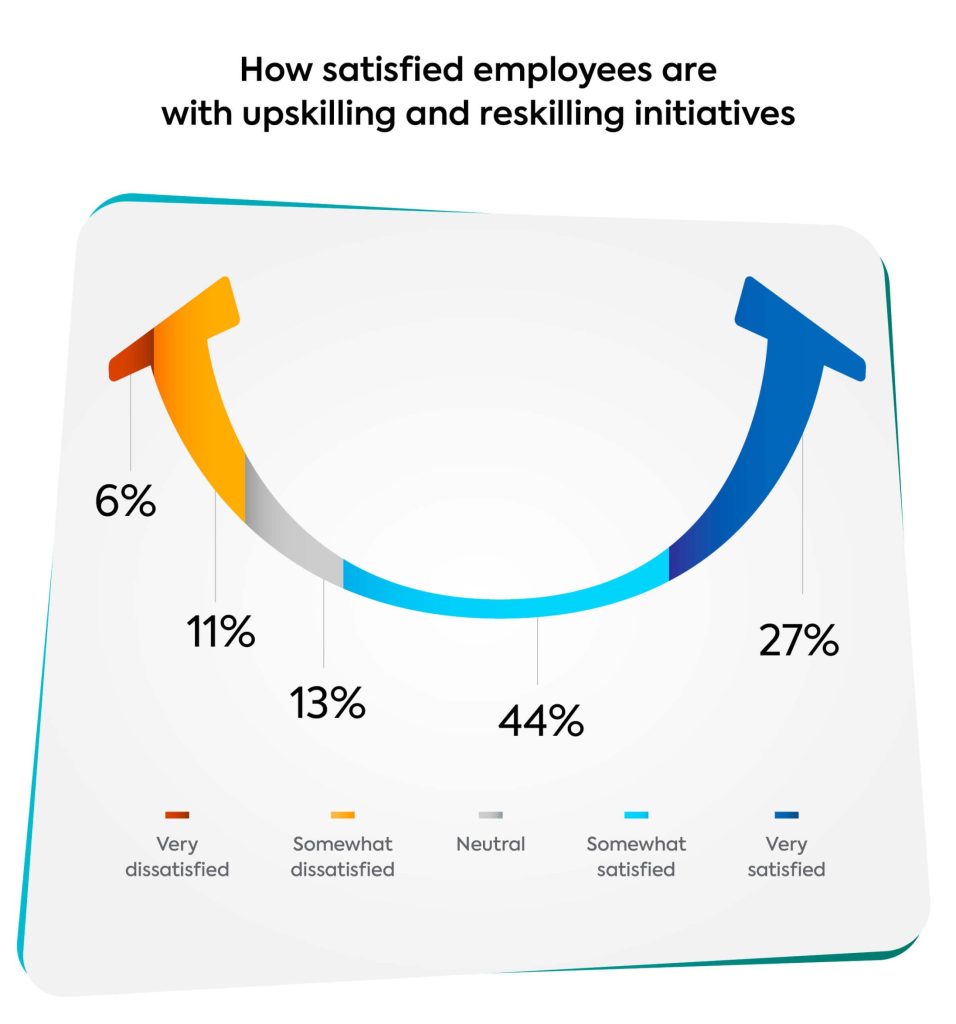
High employee satisfaction
General perceptions of upskilling and reskilling are encouraging, with 71% of employees expressing overall satisfaction with their upskilling and reskilling training. But what, specifically, are they satisfied with?
Digging deeper into quality, volume, and variety of training content, we uncovered a series of positive indicators associated with upskilling and reskilling. Sixty-five percent of employees value the variety of skills offered. Plus, 67% commend the quality and innovation of the training. And 65% are happy with the amount of upskilling and reskilling initiatives their employer has provided.
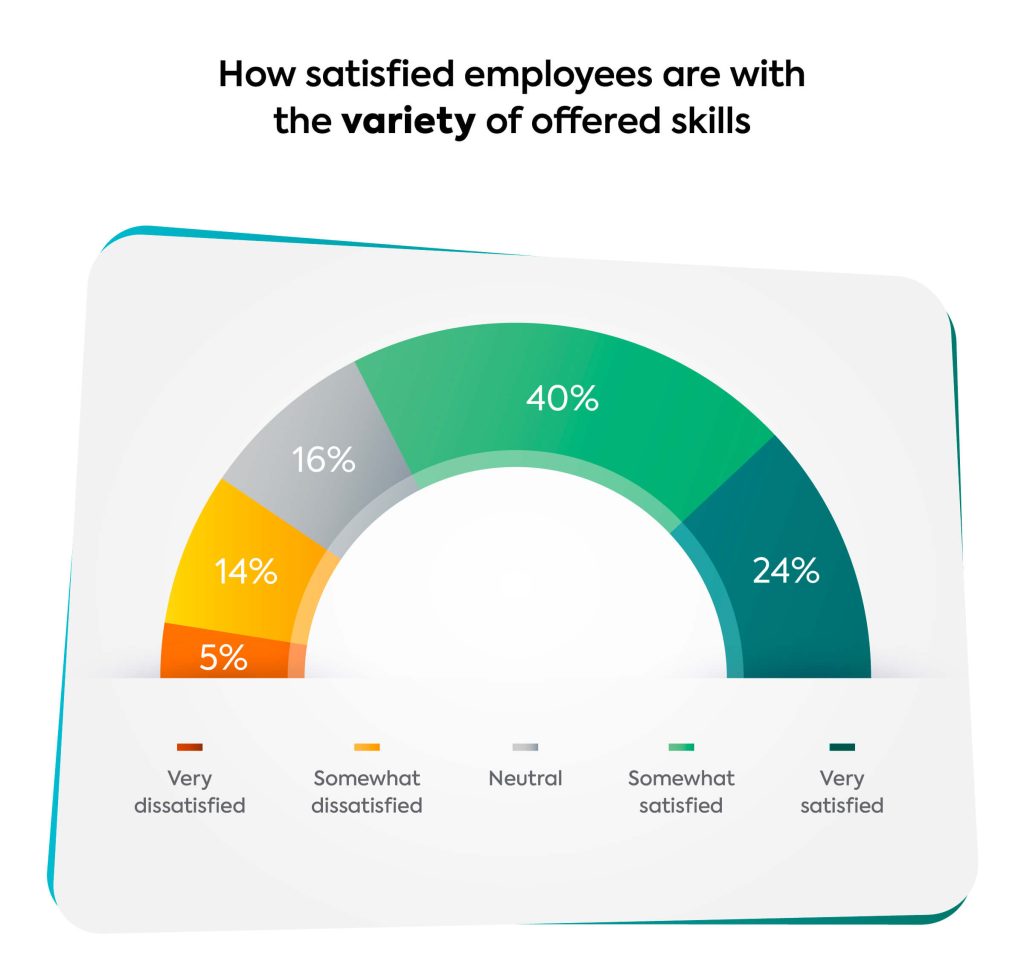
Yes, 19% aren’t satisfied with the variety of offered skills. And this figure mustn’t be ignored. But overall, these stats indicate a well-established foundation to grow from.
An increased appetite for learning
So, what do employers need to do to build on this foundation? Peering into the heart of the matter, our research exposes a robust need for quantity as well as quality.
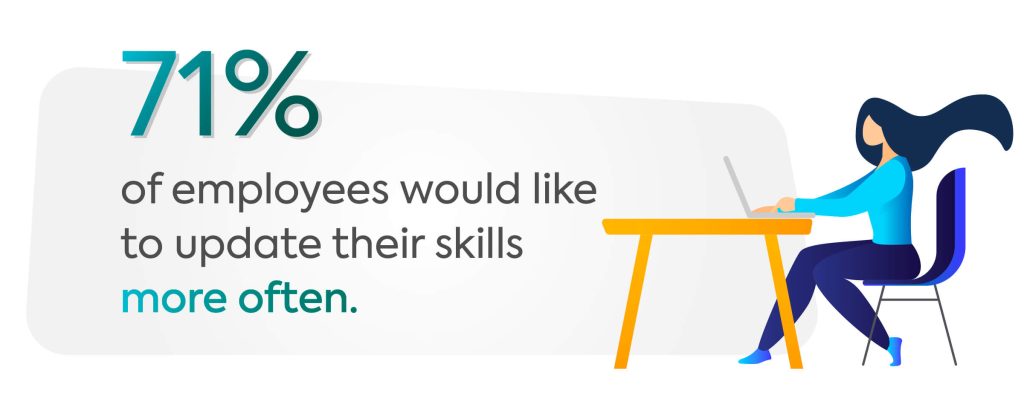
Sixty-five percent of employees may be generally satisfied with the amount of upskilling and reskilling initiatives they’ve received. But that doesn’t stop them wanting more. Seventy-one percent of employees express a desire for more frequent updates to their skill sets. And 80% believe their employers should amplify their investment in upskilling and reskilling. Simply put, employees now are not just open to learning; they’re eager to do it.

“Double down on continuous learning.”
Meghan M. Biro | Founder and CEO at TalentCulture
“Change is a fact of business life. Yet these days, everything seems to be moving faster than ever. Experts now say the typical skill becomes obsolete in five years or less. Meanwhile, innovation keeps disrupting the status quo. But if your organization can’t predict which skills will matter down the road, how can you prepare?
It’s not easy. That’s why forward-thinking employers don’t lean on hiring, alone, to fulfill all their talent needs. In addition, they invest in workforce development to build diverse skills from within. Clearly, employees love this strategy — with 80% requesting more upskilling and reskilling opportunities, and 71% hoping to refresh their skills more often. So, if you’re an employer with a receptive workforce, why wouldn’t you double down on continuous learning? If you don’t make it happen, I guarantee your competitors will.“
Room for improvement
Our research also uncovered an early wake-up call for employers. One example is skills variety. On the one hand, general satisfaction with upskilling and reskilling training is high at 71%. But the new figure represents a decline from the 78% satisfaction rate reported in 2020. This diminishing level of satisfaction suggests that now is a good time for employers to reassess, refresh, and replenish developmental strategies. And to reinstate an upward trajectory by meeting the evolving demands of their workforce.
What motivates employees to learn new skills?
Demand for upskilling and reskilling is clearly high. But some of these figures hint at a slight contradiction. For example, how can employees be satisfied with the level of current provision, and still crave more?
Here’s where context is key.
Knowing that 78% of employees are motivated to complete work-related training is encouraging. But understanding ‘why’ gives us actionable insights. It provides a pathway into the reasons demand is growing. And suggests the kind of training employers should be targeting to meet that demand, and boost satisfaction further.
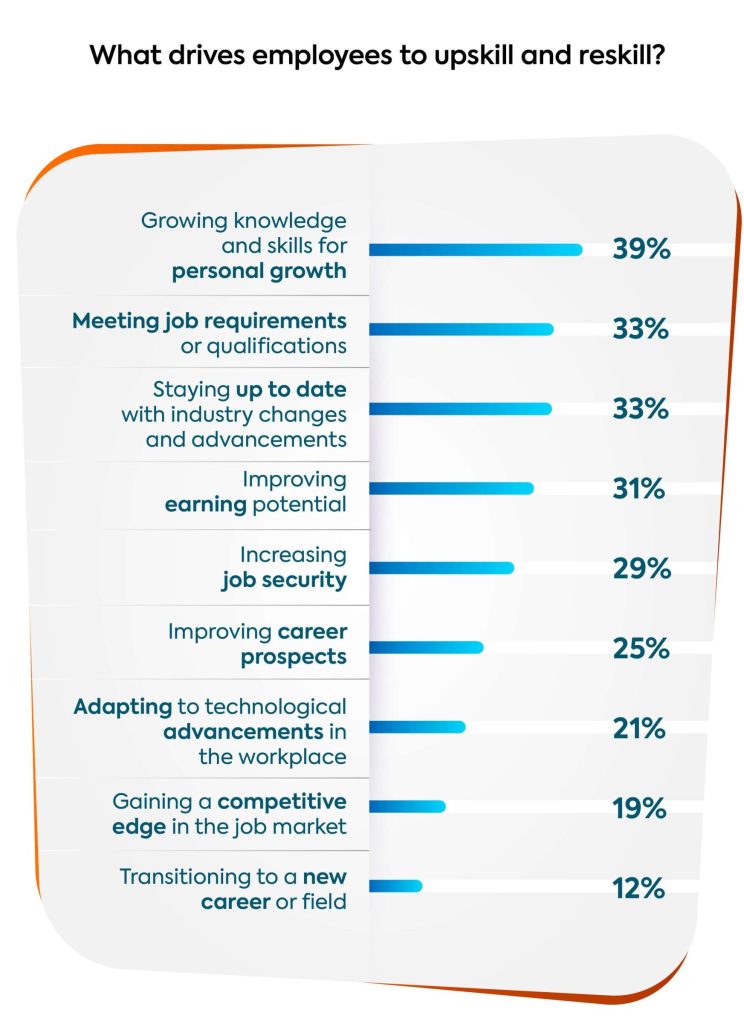
To source actionable insights, we broke down that headline figure and zoned in on mindset. Specifically, what truly drives employees to sharpen their pencils and explore the world of upskilling and reskilling? The motivators that emerged collectively paint a picture of a workforce that values continuous learning for two distinct reasons. As a must-havea tool for career stability and progression, but also as a standalone component of personal growth.
Prep your organization for the future of skills
Unlock your teams’ full potential with TalentLMS.
Sign up in seconds, test the platform forever, upgrade whenever.
Personal growth outweighs professional advancement
At the top of this educational journey is a quest for personal growth. Traditionally a nice-to-have in terms of motivators, it received the most votes—with 39% of all employees including it in their top 3 list. This compelling pursuit of knowledge and skill enhancement for personal enrichment highlights a deeper, intrinsic value placed on learning. A value that goes beyond the confines of professional advancement, or mere job necessity.
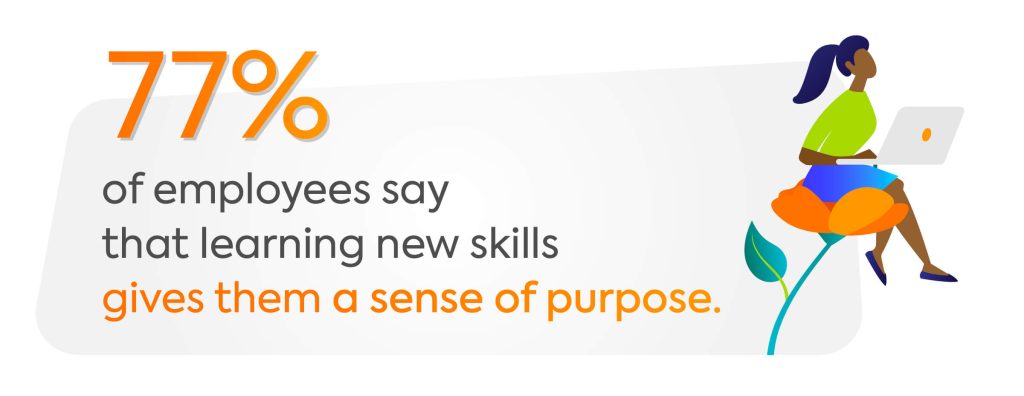
Active agents, not passive participants
For 77% of employees, learning new skills gives them a sense of purpose. Thirty-three percent of respondents include meeting job requirements or qualifications in their top 3 motivators. The same number of employees cite a need to stay up to date with industry changes and advancements. Further, an even bigger proportion (37%) harbors concerns over their skills becoming obsolete.
Combined, these results send out a clear signal that employees are aware of the rapidly evolving work landscape that surrounds them. And have decided not to be passive participants in their career trajectories. Instead, they’re actively seeking ways to ensure their relevance, achieve stability, and elevate their marketability.

“Employees seek growth and purpose.”
Dr. Heidi Kirby | Co-founder at Useful Stuff | Host of the BLOC Podcast
“Employees seek growth opportunities and purpose, so offering just a large collection of training materials doesn’t equate to a thriving learning culture. Your people should be able to see how the work they’re doing contributes to the organization’s overall goals and success. Learning paths should be created and curated based on promotion and development opportunities within the company. Employees will be engaged by being able to clearly see how their efforts are tied directly to their goals, performance, and opportunity to grow within the organization.“
Differences in upskilling and reskilling
So far, we’ve grouped upskilling and reskilling initiatives together. But the two perform different functions. Upskilling builds on existing skills. It helps employees progress in a current career path, or improve performance in a current role. Reskilling trains employees in an entirely new skill set, with the end goal to pivot to a different job or career path.
What’s the difference between upskilling and reskilling?
Upskilling: Expanding skills to progress in a current career path, or improve performance in a current role.
Reskilling: Learning entirely new skills to pivot to a different job or career path.
To take the pulse of where employers are currently focusing their attention, we separated the two. Then, we asked employees to apply a satisfaction rating to each individually.
The findings reflect a definite preference in terms of training purpose. Thirty-eight percent of employees received a combination of both upskilling and reskilling opportunities. But, when employers made an either/or choice, a clear winner emerged. Almost half (48%) of employees were offered upskilling training, compared to 15% who received only reskilling.
Satisfaction with upskilling training is also notably higher than with reskilling. Specifically, 73% of employees who received upskilling are satisfied with the training, compared to 62% of those who took part in reskilling initiatives. Which suggests job roles may be evolving, and skills may be at risk of becoming obsolete. But employees aren’t trying to transition into brand new roles. And employers don’t see it as a priority. Yet.
Unlocking employee potential with upskilling and reskilling
Career stability and career progression are clearly powerful motivators when it comes to upskilling and reskilling. But how far, to-date, have existing skills-building initiatives satisfied that demand? To establish a benchmark, we asked respondents to evaluate levels of success in six key areas. Here’s what we found.
Competitiveness in the job market
Our data revealed that 61% of employees link upskilling and reskilling with their competitiveness in the job market. This statistic underscores the importance of investing in continuous learning initiatives, to keep employees relevant and attractive candidates in an ever-evolving landscape.
Job security
Job security is a primary concern for employees in today’s uncertain economic climate. But 64% of employees we surveyed agree that upskilling and reskilling increases confidence in this area. And that by equipping employees with the skills needed to navigate industry changes and technological advancements, organizations can instill a sense of stability within their workforce.
Job performance
According to 69% of respondents, upskilling and reskilling training has been beneficial for their job performance. The message here is that, by continuously updating their skills and knowledge, employees are better equipped to meet the demands of their roles. Which, in turn, leads to higher productivity and performance outcomes, for both individuals and organizations.
Adapting to changes
Navigating changes in roles or industries can be daunting. But our survey data indicates that upskilling and reskilling training plays a crucial role in offsetting this. Nearly 2 out of 3 respondents (64%) report that such training has been useful for building confidence in navigating changes. This highlights the importance of investing in continuous learning initiatives, to support employees through periods of transition and uncertainty.
Additionally, 65% of employees credit upskilling and reskilling training for enhancing their ability to adapt to new technologies. By providing access to the skills needed to leverage emerging technologies, organizations can ensure that their workforce remains agile and capable of driving innovation.
Financial wellness
Financial stability is a key concern for employees. And our survey data suggests that upskilling and reskilling training can have a positive impact in this area. One out of two respondents (52%) reports that such training has been beneficial for their financial well-being. And nearly a third of all employees (31%) take part in upskilling and reskilling initiatives to improve their earning potential.
Professional growth
Professional growth is a priority for many employees. According to 67% of respondents, upskilling and reskilling training play a significant role in supporting this goal.
The good news for employers is that professional growth doesn’t just enhance individual skills and knowledge. It fosters a broader culture of growth, innovation, and resilience. All these contribute to overall workforce stability and prosperity. In short, ongoing development initiatives power both individual and collective success.
10 tactics to improve skill development initiatives in your organization
So, how can employers harness all of this information and turn insights into next steps? Here are 10 strategies, with a series of supporting tactics, to help provide structure and clarity.
#1 Level up skills variety
WHAT DID EMPLOYEES SAY?
“Employees expressed dissatisfaction with the range of skills offered. They cited limited availability of specific skills as a barrier to upskilling and reskilling. They also remarked that programs are not frequently updated with new industry skills.”
WHAT CAN EMPLOYERS DO?
- Use skills surveys to learn what additional upskilling and reskilling training employees want.
- Conduct skills gap assessments to evaluate current capabilities against future operational requirements.
- Invest in an eLearning platform with a a training library that provides access to a wide range of ready-to-go courses.
#2 Make training relevant and actionable
WHAT DID EMPLOYEES SAY?
“Most employees want more relevant training. And those facing challenges in training worry they won’t be able to apply skills successfully. They’re also hindered by a fear of failure. ”
WHAT CAN EMPLOYERS DO?
- Include immersive and interactive learning strategies in training modules. For example, simulations, role-plays, digital storytelling, and 360° images and videos.
- Use personal development plans to ensure skills are relevant, and clearly linked to job roles and wider organizational goals.
- Adopt adaptive learning technologies to provide learners with training that’s tailored to their specific needs. Employees can use these to master topics and build confidence before moving on.
#3 Opt for little and often
WHAT DID EMPLOYEES SAY?
“Employees want to update their skills more frequently. But some of the biggest obstacles they face include lack of time, and difficulty balancing work with learning. Time constraints are a particular challenge for on-site employees.”
WHAT CAN EMPLOYERS DO?
- Provide on-the-job learning opportunities and training at the point of need.
- Support both synchronous and asynchronous learning to balance structure with flexibility.
- Level up self-paced learning by incorporating microlearning modules into training programs.
#4 Add age into the equation
WHAT DID EMPLOYEES SAY?
“Attitudes and experiences of upskilling and reskilling vary across different generations. The oldest generations have more positive views. Gen Z stands out as having notably more negative opinions and experiences, compared to other age groups.”
WHAT CAN EMPLOYERS DO?
- Use insights around age segmentation to design training that targets the various challenges, views, and behaviors of each group.
- Apply a blended learning approach (a mix of training methods) to appeal to different learning styles of employees across generations.
- Encourage older employees to mentor younger generations, and share best practices and success stories regarding upskilling and reskilling.
- Consider ways to engage Gen Z specifically:
- Reaffirm positive standards, values, and outcomes regarding upskilling and reskilling during hiring and onboarding.
- Design a bespoke, internal L&D comms campaign around upskilling and reskilling that targets this particular group.
#5 Consider level-specific differences
WHAT DID EMPLOYEES SAY?
“Nearly one fifth of companies offer no level-specific training. And those that do, prioritize entry-level or mid-career professionals.”
WHAT CAN EMPLOYERS DO?
- Conduct a needs assessment to identify the specific skills and knowledge gaps at each career stage. Compare this with current, level-specific training strategies, and make changes as required. Or, design training around this—if level-specific training doesn’t already exist.
- Assess training provision for execs and senior leaders, and invest more if there is a need and/or a demand.
#6 Build on preferences for digital learning
WHAT DID EMPLOYEES SAY?
“Employees showed a preference for digital and flexible learning methods when it comes to upskilling and reskilling. Online, company-provided, self-paced training leads satisfaction rates.”
WHAT CAN EMPLOYERS DO?
- Deliver training through an online eLearning platform (LMS) that works well with other 3rd party digital apps and platforms.
- Integrate more technology-driven solutions and strategies into training programs. For example, mobile learning, video content, gamification, and social learning.
- Use customization features included in eLearning platforms to apply company branding to online, self-paced training modules.
#7 Create a healthy training culture
WHAT DID EMPLOYEES SAY?
“Nearly a quarter of all employees complete training either during breaks, at weekends, or after work. Employees who do this are more dissatisfied with the training than colleagues who completed it during work hours.”
WHAT CAN EMPLOYERS DO?
- Give all employees (remote and on-site) structured time-slots for training. Empower employees to take control, and use these time-slots when and how they want to.
- Define expectations around the practicalities of training (the ‘when’ and ‘how’), in policies and internal guidance.
- Promote healthy values and attitudes to training during onboarding.
- Include training in well-being initiatives to link healthy learning practices with good mental health.
- Encourage and support senior leaders to set a positive example of training. For example, by dedicating time during the working day for it. And by sharing successes and including training updates in team meetings.
#8 Tap into deeper aspirations
WHAT DID EMPLOYEES SAY?
“A quest for personal growth is the top employee motivator for learning. Employees are hungry for knowledge that exceeds the mere practical, and goes beyond job-related capabilities.”
WHAT CAN EMPLOYERS DO?
- Nurture a culture of continuous learning. For example, by recognizing and rewarding learning achievements, sharing success stories, and making learning resources widely available.
- Support lifelong learning. Open up access to courses in unrelated fields, and give employees time off for external study or other educational pursuits.
- Pair employees with mentors or coaches who can provide tailored advice, support, and encouragement. Align this with each employee’s personal aspirations.
- Include training in soft skills that underpin personal growth. For example, leadership, emotional intelligence, resilience, communication, and critical thinking.
#9 Share control
WHAT DID EMPLOYEES SAY?
“Employees agree that learning new skills gives them a sense of purpose. Learners don’t want to be passive participants in their career trajectories. They want to be proactive, and forge their own path.”
WHAT CAN EMPLOYERS DO?
- Promote self-directed learning techniques to give employees an element of autonomy over their learning pathways.
- Source regular feedback from employees on training initiatives. And make tangible changes based on their opinions and suggestions.
#10 Break down the walls
WHAT DID EMPLOYEES SAY?
“Fully remote workers experience more obstacles than their on-site colleagues. They’re also more dissatisfied with upskilling and reskilling initiatives. For fully remote workers, limited availability of programs for relevant skills ranked highest in terms of challenges. For on-site employees who experience barriers to learning, lack of time is the biggest issue.”
WHAT CAN EMPLOYERS DO?
- Leverage technology that maximizes accessibility, and fosters virtual collaboration and interaction.
- Support flexible scheduling. Offer multiple sessions at various times, to accommodate different time zones and work schedules. Record sessions for later viewing, and include asynchronous learning options.
- Give on-site employees dedicated physical spaces for training (for example, meeting rooms and learning pods). Make these bookable in advance. And design them so they eliminate or reduce visual and auditory distractions.
- Be mindful of proximity bias when gathering training feedback. Consider if location influences attitude, alongside other factors.
- Standardize content delivery. Ensure that the quality of training content is consistent across all formats, whether delivered in-person or online.
- Provide technology and troubleshooting support to all learners. Make sure this is reliable and easily available.
A generational divide in satisfaction
The modern workforce boasts unprecedented levels of diversity in terms of employee age, with Boomers at one end of the scale and Gen Zers at the other. Each generation brings its own set of values, expectations, and experiences to the mix. And our research suggests these also extend to attitudes to upskilling and reskilling.
It’s important to note that the sample sizes, here, vary across different age groups. So our findings on this subject are indicative rather than definitive. But, for employers, there’s lots to spark interest and, potentially, inspire further investigation.
Closing the (age) gap
The results of our survey paint a vivid picture. Satisfaction with upskilling and reskilling programs grows with age. It peaks at 77% for employees over 54 years old, and bottoms out at 54% among Gen Z employees.
The desire for greater investment in upskilling and reskilling also polarizes the oldest and youngest generations. More than half (54%) of 18 to 24-year-olds say companies should invest more, compared to a staggering 86% of employees over 54 years.
Understanding the modern mindset
Drilling down into data that explores actions as well as attitudes, we learned more about the unique perspectives of the workplace’s youngest generation. We discovered that Gen Z employees invest more personal time in upskilling and reskilling.
Twenty-nine percent complete their training outside of work hours, a far higher figure than any other age group. Gen Z employees also find participating in upskilling or reskilling programs more challenging compared to other age groups. Over a third (34%) experience barriers to learning, contrasting with just 15% of employees aged over 54 years. Adding context to this, among the third of all Gen Zers who experience training challenges, 20% don’t think that their manager or supervisor understands their skill development needs.
Time to target the “benchmark generation?”
The differences that exist across the five different generations give employers rich food for thought. At a top level, they highlight a critical need for training initiatives to be targeted and flexible. But the strong, standalone attitudes of Gen Z employees suggest a general adaptability may not be enough. And that the Gen Z mindset may warrant a bespoke training strategy.
After all, Gen Z will soon surpass Millennials as the most populous generation on earth. So, it’s no great leap to expect this so-called “benchmark generation” to play a bigger role in defining expectations. Or even to start setting the overall standards for training moving forward.
An ‘Upskilling Study’ by Workplace Intelligence certainly adds urgency to this call to action. In 2022, they reported that 74% of Millennial and Gen Z employees planned to quit within a year, due to a lack of skills development opportunities.
Obstacles to upskilling and reskilling
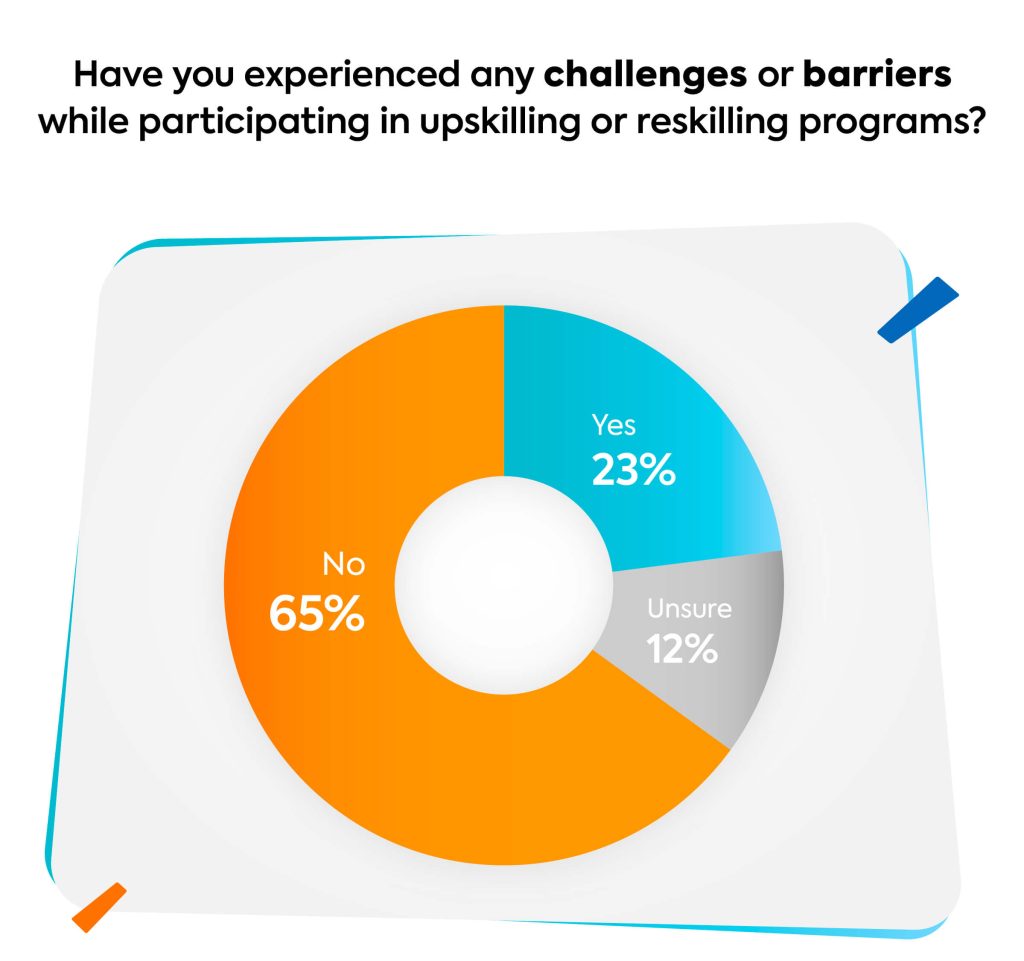
In training, planning for success means planning for problems too. Knowing what barriers may emerge along the way results in more robust initiatives, and more successful outcomes. Our research revealed that obstacles to participation are present for almost a quarter (23%) of all employees.
But what, explicitly, do employers need to consider when designing future upskilling and reskilling initiatives?

“Identify what’s worth dedicating time to.”
Nicole Papaioannou Lugara, PhD | Founder at Your Instructional Designer
“Productivity is a key focus for most business agendas. But sometimes, balancing productivity with learning can be challenging, especially when dealing with talent shortages. As our markets evolve at breakneck speed, we’ll see the acceleration of this trend.
To stay on top of current business needs, L&D leaders need to create plans that emphasize learning and work as part of the same ecosystem. This might look like learning in the flow of work, knowledge sharing via organizational social media, or integrating work activities and feedback into formalized training.
L&D also needs to set clear priorities and guide leadership to support those priorities. People can’t give their full attention and energy to everything. So, identify what’s worth dedicating time to. Start with a skills inventory and all-levels listening tour. These high-priority learning goals may evolve over time, but they should be the center of your learning strategy.“
Key roadblocks: Time, work-learn balance, and skills variety
So often, content and design steal the show when it comes to corporate learning. But for them to resonate, you first need to provide a clear access route. Among all of the respondents who experienced obstacles to upskilling and reskilling training, functionality came top of the agenda. The 3 biggest roadblocks according to this embattled group of employees were all logistical ones. Specifically, lack of time, difficulty in balancing work and learning, and limited availability of programs for specific skills.
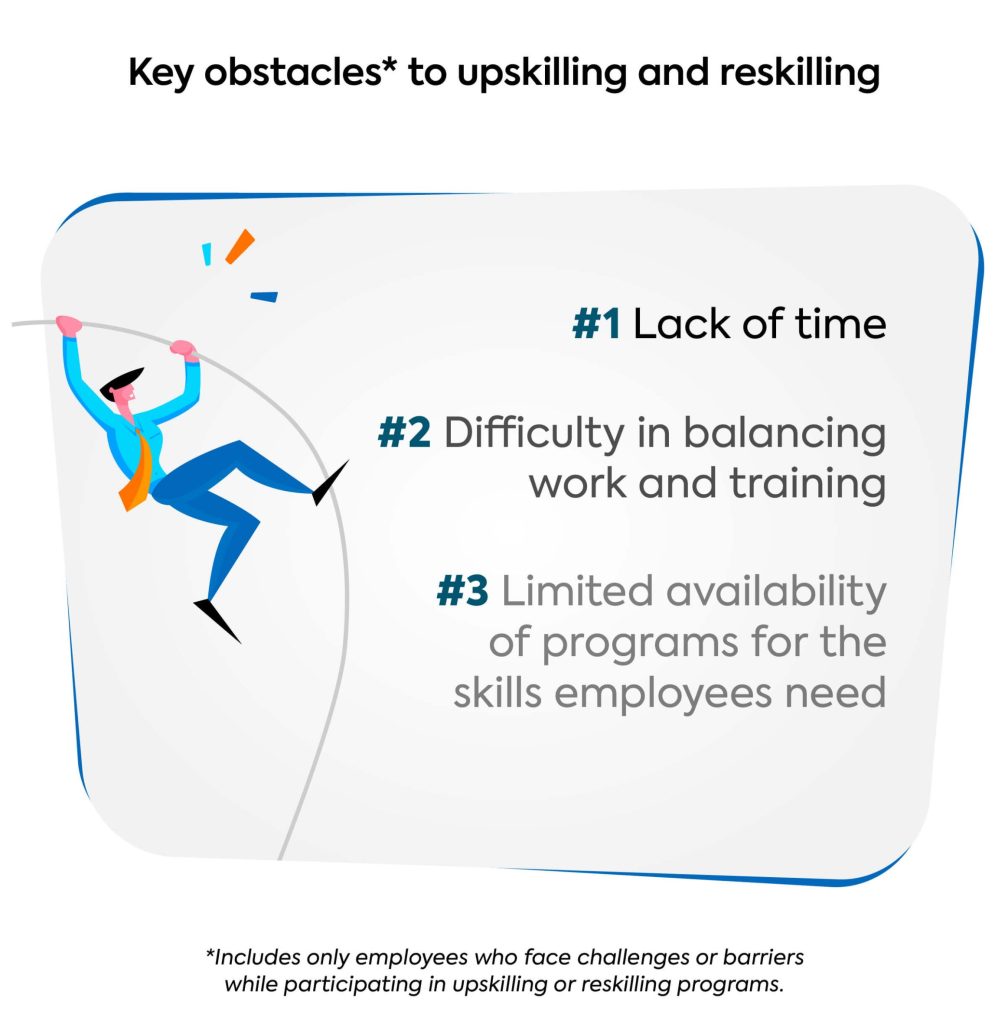
Fear of failure and concerns about performance
Our data shows that access to learning is impacted by sentiment as much as practical domain. Fear of failure is an obstacle for 23% of employees who face challenges. And for those struggling to balance training and work, worry about underperformance is a tangible concern.
Specifically, difficulty in balancing work and training is an obstacle for 29% of employees who face challenges while participating in upskilling or reskilling programs—they worry that dedicating time to learning may lead them to underperform at work.
Does distance damage learning?
Hybrid and remote working now feature firmly within the operating model for most businesses. Insights from Gallup show that, as of February 2024, the majority of remote-capable employees are in a hybrid or exclusively remote arrangement. But what impact, if any, does this have on upskilling and reskilling initiatives?
Filtering our results by working arrangement opens up lots for employers to consider. The key takeaway? Where employees are located appears to have a bearing on barriers to upskilling and reskilling, both in terms of volume and type.
Among employees based fully in an office or on-site, 22% experience obstacles. This figure rises sharply to 33% for fully remote workers. Satisfaction rates track this trajectory. They peak at 75% for on-site employees (above the 71% average figure for all employees), but drop to 61% for remote employees.
Interestingly, for on-site employees experiencing challenges, the most common obstacle is lack of time. Almost four out of ten (39%) in this group voted for it. Yet only 16% of remote employees included it on their list of top 3 obstacles to learning. In the fully remote category, limited availability of programs for relevant skills ranked highest in terms of challenges. It was an obstacle for 28% of this segment.
What do skill-building programs look like?
As we’ve seen from the data, some of the major barriers to participating in skills-building programs are practical ones. Time and accessibility, in particular, are big stumbling blocks. And, while motivation levels of learners are usually personal, they’re often impacted by logistics too. In short, the ‘when’, ‘how’, and ‘who’ of training matter. To help employers make the connections they need to drive improvements, our survey zoned in on the logistics of skill-building program delivery. Here are the relevant insights.
Out-of-hours learning loses favor
The most common time for employees to complete training sessions is during working hours. An additional 22% of employees have even more structure within that, using dedicated slots set aside by their employer to focus in on skill-building programs. This is reassuring. But there’s a darker side to delivery. Nearly a quarter of employees undertake upskilling or reskilling either outside of working hours (after work or on weekends), or during breaks.
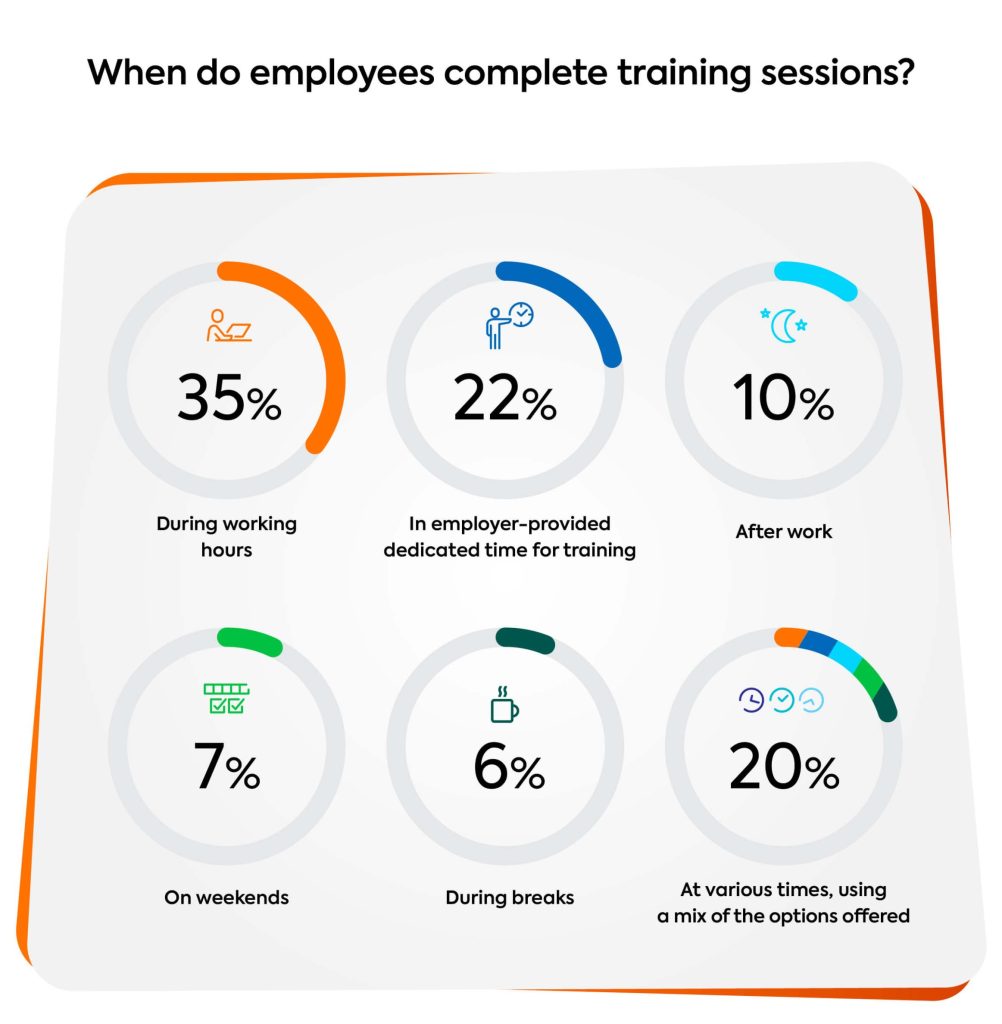
Linking these results with insights around satisfaction levels confirms what Gen Z’s generational data also revealed. Which is that the more personal time employees spend on training, the less happy they are with it. Setting the example of Gen Z aside, 26% of all employees who underwent upskilling after work hours were dissatisfied. This compares to a more negligent 12% dissatisfaction rate among those who received training during work hours.
Digital delivery sets the standard
Analyzing the ‘how’ behind training delivery, it’s apparent that ‘online’ is the magic word. When asked to select the most common delivery methods for upskilling and reskilling training, 51% of respondents chose online, company-provided, self-paced training.
Meanwhile, 34% selected online, company-provided, live sessions. These ranked 1st and 3rd in the top 3 list of popular methods, but received the top 2 highest satisfaction rates. Specifically, 74% for self-paced training, such as online courses and mini degrees. And 73% for company-provided live sessions, such as webinars and instructor-led sessions.
Satisfaction rates are lower for on-site, instructor-led training, and in-person external events. Overall, the learning landscape for upskilling and reskilling suggests a preference for digital and flexible learning methods. And that employers are on the right track with this.
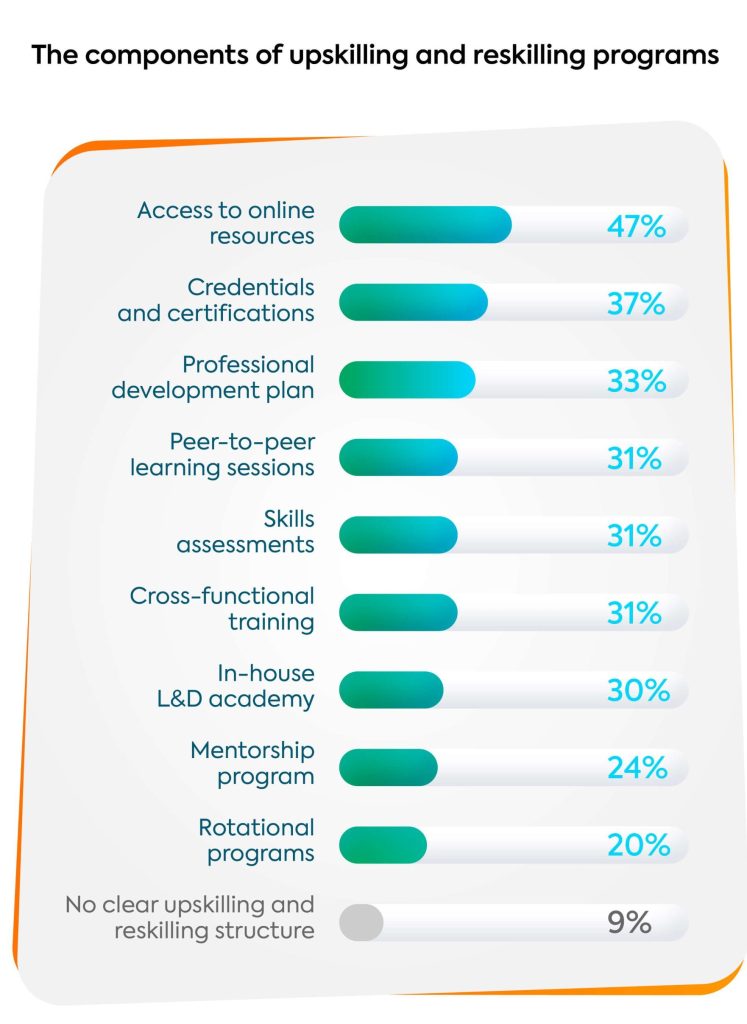
Online resources support the strategy for digital learning
Digital delivery also sits at the top of the list of components that support upskilling and reskilling programs. In this category, 47% of employees receive online resources. The closest competitors are credentials and certifications (37%), and professional development plans (33%). These are followed by peer-to-peer learning sessions, skills assessments, and cross-functional training. All of the above are included in 31% of programs. Strategies lower down the list include in-house learning and development academies, mentoring, and rotational programs.
This category also presents some notably positive feedback for employers (especially HR teams and L&D leads). Only 9% of employees report a lack of a clear structure to their companies’ development plans.
Senior leaders miss out on level-specific training
Level-specific training targets the unique skills and needs of employees at varying stages in their profession. This starts with employees at the beginning of their career, going all the way up to experienced executives. Exploring what this looks like in terms of upskilling and reskilling, we unearthed the following insights: 83% of employees said their companies offer level-specific training programs.
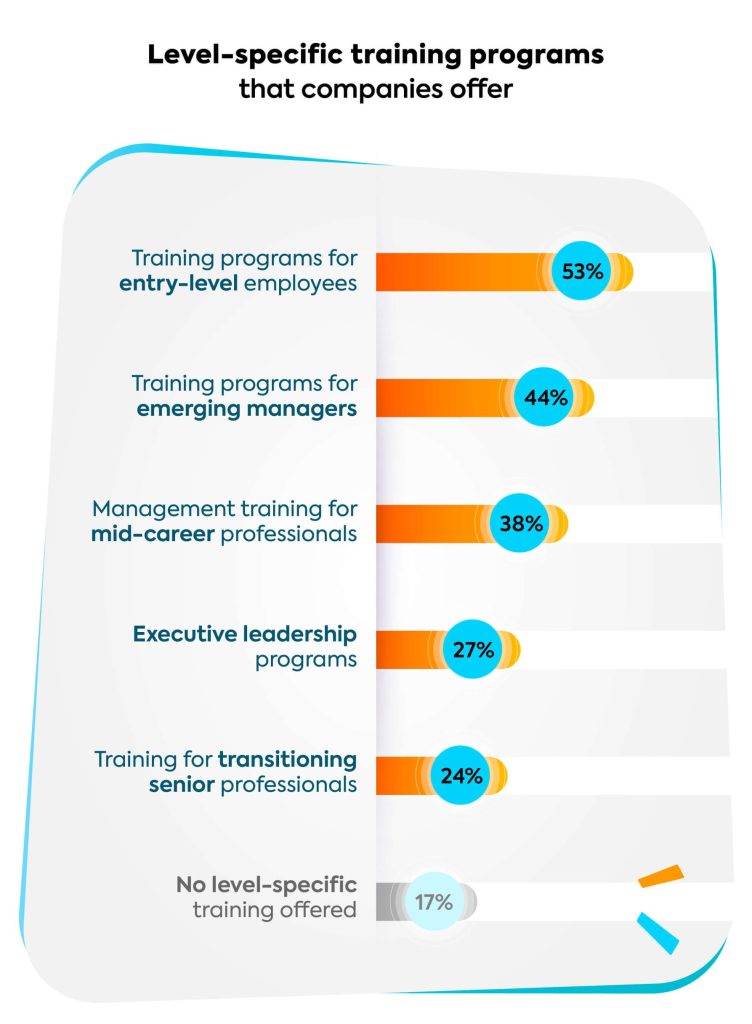
According to a ‘Future of Work and Skills’ study by PwC, a lack of leadership development is 1 of the 3 most significant inhibitors to organizational success. This additional insight brings our research into focus, showing that investment in leadership development is significantly lower than other segments. And could be a potential stumbling block for employers, moving forward.
The future of upskilling and reskilling: 5 key trends to track
It’s no secret that the future of learning is taking shape in exciting and transformative ways. The advent of artificial intelligence (AI) is proving to be a notable game-changer. But, while technology is a crucial factor, a range of other factors are influencing the shifting landscape of skills acquisition and professional development.
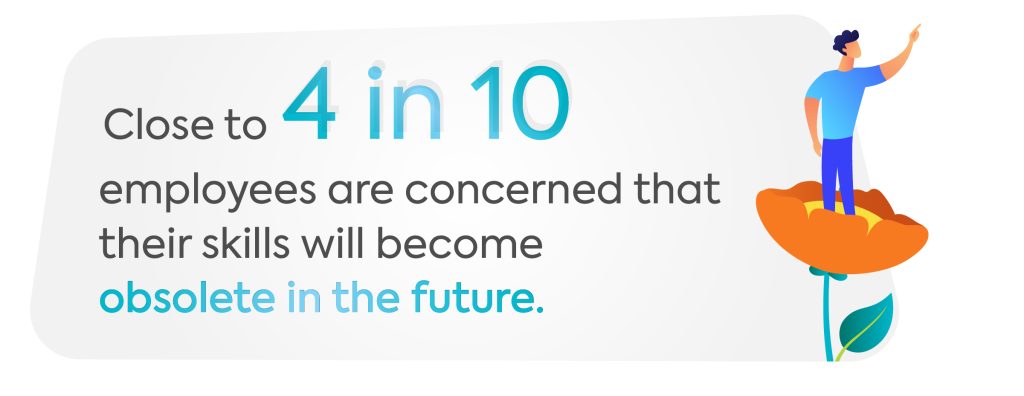
Our survey data offers valuable insights into 5 key emerging trends in learning. Let’s delve into our findings, and what they mean for employers planning future training initiatives.
#1 Emerging tech and AI skills
According to ‘The Future of Jobs Report 2023’ by the World Economic Forum, AI skills represent the third-highest priority for company training. And employees responding to our survey understand this urgency. While 47% of employees don’t currently use AI skills in their roles (graph 11), 55% recognize the increasing importance of AI proficiency in their industry.
This discrepancy suggests a growing divide between the skills employees currently possess and the skills they anticipate needing in the near future.
Our data also reveals a strong correlation between AI proficiency and career advancement. More than half (56%) of employees believe that AI skills will enhance their career prospects. And 57% acknowledge they need to improve their AI skills to stay competitive.
Despite these insights, only 41% of employees indicate that their company’s upskilling and reskilling programs provide AI skills training. This hints at a potential gap between employees’ learning needs and organizational support for AI skills development.
The data also underscores a growing demand for AI integration in various job roles. Half of employees (50%) agreed that their current jobs would benefit from the integration of AI technologies. This finding highlights the increasing importance of AI skills across job functions. And suggests a need for organizations to proactively address the skills gap through targeted training and development initiatives.

“Prioritize investing in comprehensive AI training programs.”
Mike Cooke | Chairman and CEO at Brandon Hall Group
“The data reveals a growing awareness among employees about the importance of AI skills in their current roles and future career prospects. However, with over 40% of employees already utilizing AI in their jobs, adoption has yet to reach full speed. There’s ample room for leaders to integrate AI more deeply into the workflow across roles and functions. AI is becoming a part of the modern workforce, and there’s no turning back.
Only 41% of employees report that their company’s upskilling and reskilling programs include AI skills, highlighting a gap between employee needs and organizational offerings. This is particularly concerning given that over a third of employees are worried about their current skills becoming obsolete in the future.
Bottom line is, organizations must prioritize investing in comprehensive AI training programs. By doing so, they can not only support their employees’ professional development but also position themselves for long-term success in an AI-driven business landscape. We are just beginning to explore the vast potential of how businesses can effectively leverage AI, and there is still much to discover.”
#2 Skill-based growth and development
Gone are the days when a college degree was the golden ticket to career opportunities. Instead, skills-based hiring is gaining traction as a preferred approach to talent acquisition and development.
Skills-based hiring emphasizes the importance of competencies and capabilities over traditional qualifications. And 60% of the employees we surveyed (Graph 3), say their companies practice this approach.
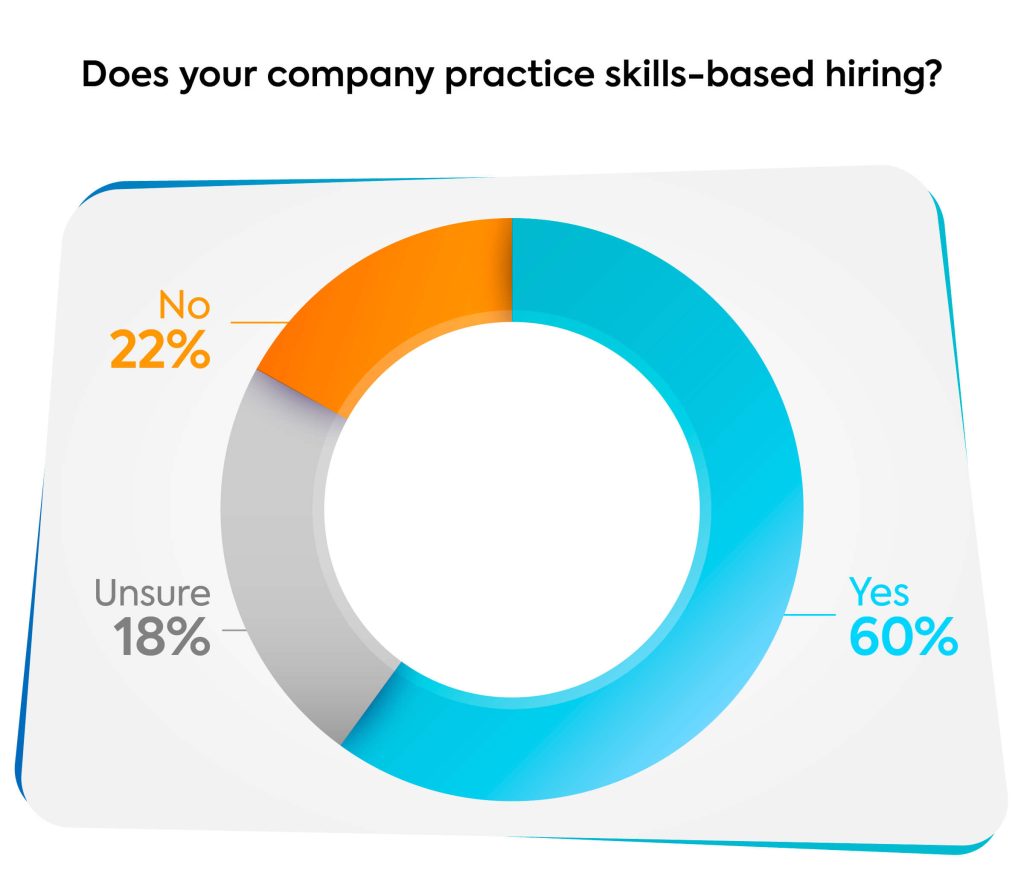
There are good reasons for this emerging shift. A skills-first approach allows companies to have access to a broader talent pool, including self-taught experts, career changers, and those with unconventional career paths.
But not every job is eligible for skill-based hiring. To make it a success, organizations need to clarify specific requirements, enact organizational shifts, and ensure the alignment of HR teams with their strategic vision.
So, while our report underscores this as an emerging trend, it’s evident that companies have yet to fully embrace this model. And, given the complexities involved, it’s not hard to understand why.
#3 Transparency and clarity
The percentage of employees who understand the end goal of their company’s upskilling and reskilling efforts is high: 74%. This underscores the importance of clear and transparent communication in learning initiatives.
In the future, organizations will likely need to prioritize effective communication strategies to ensure employees are well-informed, and engaged in their learning journeys.
#4 Personalized learning experiences and skill paths
There’s no one-size-fits-all approach to upskilling and reskilling. Our data shows that the more relevant training is to each learner, the more positively it’s perceived. Two key areas of our investigation, in particular, highlight this: managerial understanding, and alignment of skills.
Sixty-nine percent of all employees feel that their manager understands their skill development needs. And, of those, 79% are satisfied with their training. Of the 17% who don’t feel their manager understands their skill development needs, only 11% are satisfied with their training.
This pattern continues with the alignment of skills. According to 70% of respondents, upskilling and reskilling initiatives currently sync up with job responsibilities and strategic goals. As a result, they are more successful.
This sets out a clear call for personalized learning and development plans. And for relevant, job-specific training that ties in with both employees’ and organizational goals.
#5 Flexibility and adaptability
Our survey reveals that general satisfaction levels also increase when flexibility is built into the learning equation. Sixty-seven percent of respondents are satisfied with the flexibility of the learning process. Of those, 77% are content with training in general (compared to 71%). This suggests that adaptability should continue to feature as a crucial aspect of future learning initiatives.
The nature of work is ever-changing. By providing flexible options, like self-paced learning, employees are better-placed to pivot quickly to meet new challenges and opportunities.
Conclusion: A powerhouse for growth
The future of learning is dynamic, multifaceted, and full of opportunities. Employees are eager and excited to hop on board. They know their skill sets need to evolve to keep pace with changes in the workplace and beyond. And they’re motivated to keep growing their capabilities to progress internally, and compete on the external job market.
TalentLMS and Workable’s latest research into upskilling and reskilling suggests current skills gap training provision is satisfactory. But, it also implies that it may not be enough for employees to succeed tomorrow. Hence the push for increased investment, despite positive levels of satisfaction with the current provision.
For employers and HR teams, this is a compelling call to action. Expectations are growing. And high demand for enhanced, more regular training opportunities, underlines a need for more considered and impactful investment in professional development.
Instead of simply ramping up the volume, employers need to take a bigger leap forward. They need to look beyond professional development, and nurture personal growth too. They need to give employees flexibility and control, while also leveling up the variety of skills on offer. Promoting a healthy and balanced attitude to learning is equally crucial.
Learning isn’t just a means to an end. In informed and inspired hands, it’s a powerhouse for growth.
There are also additional elements of fine-tuning to be done. Employee age, working arrangements, and the demands placed by new technologies, are all crying out for more attention. This is where increased personalization comes into its own—a trend that looks set to dominate training for years to come.
In short, there’s lots for employers and HR teams to work on.
But the rewards are there for the taking. As we venture into this intriguing future, it’s important to remember that learning isn’t just a means to an end. In informed and inspired hands (cue our research), it’s a powerhouse for growth that enriches individuals, organizations, and society as a whole.
Methodology
The survey was conducted online on March 15, 2024, among 1,000 employees in the US across different industries. Minor discrepancies in total figures may exist due to rounding.
Gender breakdown: Female (59%) | Male (41%)
Company size of surveyed employees: 1-50: 267 | 51-100-250: 219 | 251-500: 93| 501-1000: 104| 1001-5000: 105| >5000: 196 I N/A: 16
Age groups breakdown: 18 – 24 (10.3%) | 25 – 34 (21.2%) | 35 – 44 (24.3%) | 45 – 54 (21.6%) | > 54 (22.6%)
Work arrangements of surveyed employees: Fully in-office/on-site 52%; Hybrid 22%; Fully remote 16%; Flexible 10%;
Research team
Ana Casic (TalentLMS), Fiona McSweeney (TalentLMS), Giota Gavala (TalentLMS), Keith MacKenzie (Workable), Alexandros Pantelakis (Workable).
More workplace research by TalentLMS
Train your people. Measure results. Drive growth.
TalentLMS gives you the tools to supercharge every step of your training.


